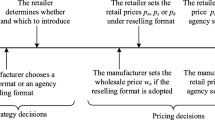Abstract
We propose a game-theoretic model involving the manufacturer of a national brand and a retailer selling her private label along with the national brand. The retailer can use either a differentiation strategy or an imitation strategy for offering her store brand. We consider two cases: the benchmark case, where both players have symmetric information and play a Nash game, and the incentive case, where the national brand’s manufacturer, acting as a leader, offers an incentive to the retailer in order to benefit from a larger proportion of the shelf space, which ultimately increases her own profit. By comparing both situations, we attempt to derive the conditions under which it is profitable for the manufacturer to implement such an incentive strategy and investigate if the results are idiosyncratic to the PL concept. These conditions are fourfold, and include the private label’s image, the price competition between the national brand and the private label, the transfer price level and the shelf-space allocated to the national brand in the benchmark case.
Similar content being viewed by others
References
Aggrawal P, Cha T (1998) Asymmetric price competition and store vs. national brand choice. J Prod Brand Manage 7(3): 244–253
Ailawadi KL, Neslin SA, Gedenk K (2001) Pursuing the value-conscious consumer: store brands versus national brand promotions. J Mark 65: 71–89
Anderson EE, Amato HN (1974) A mathematical model for simultaneously determining the optimal brand-collection and display area allocation. Oper Res 22(1): 13–21
Bultez A, Naert P (1988) S.H.A.R.P.: shelf allocation for retailer’s profit. Mark Sci 7(3): 211–231
Corstjens M, Doyle P (1981) A model for optimizing retail space allocations. Manage Sci 27(7): 822–833
Corstjens M, Doyle P (1983) A dynamic model for strategically allocating retail space. J Oper Res Soc 34(10): 943–951
Cotterill RW, Putsis WP (2000) Market share and price setting behavior for private labels and national brands. Rev Ind Org 17: 83–109
Cotterill RW, Putsis WP (2001) Do models of vertical strategic interaction for national and store brands meet the market test. J Retailing 77: 83–109
Dick A, Jain A, Richardson P (1997) How consumers evaluate store brands. Pricing Strategy & Prac 5(1): 18–24
Fernandez AN, Gomez MS (2005) Shelf space management of private labels: A case study in Spanish retailing. J Retailing Consum Serv 12: 205–216
Food Marketing Institute Report (1999) Slotting allowances in the supermarket industry. FMI News Center. http://www.fmi.org
Hansen P, Heinsbroek H (1979) Product selection and space allocation in supermarkets. Eur J Oper Res 3: 474–484
Hoch SJ, Banerji S (1993) When do private labels succeed?. Sloan Manag Rev 34: 57–67
Hoch SJ, Dhar SK (1997) Why store brands’ penetration varies by retailer. Mark Sci 16(3): 208–227
Ingene CA, Parry ME (2004) Mathematical models of distribution channels. In: International series in quantitative marketing, vol 17. Kluwer Academic, Massachusetts, p 568
Jeuland AP, Shugan SM (1983) Managing channel profits. Mark Sci 2(3): 239–272
Jørgensen S, Zaccour G (2003) Channel coordination over time: incentive equilibria and credibility. J Econ Dyn Control 27(5): 801–822
Jørgensen S, Zaccour G (2004) Differential games in marketing. International series in quantitative marketing, vol. 15. Kluwer Academic, Massachusetts, p 176
Martín-Herrán G, Taboubi S (2005) Shelf space allocation and advertising decisions in the marketing channel: A differential game approach. Int Game Theory Rev 9(3): 313–330
Martín-Herrán G, Taboubi S (2005) Incentive strategies for shelf space allocation in duopolies. In: Haurie A, Zaccour G (eds) Dynamic Games: Theory and Applications. Springer, Heidelberg, pp 231–254
Martín-Herrán G, Taboubi S, Zaccour G (2005) A time-consistent open-loop Stackelberg equilibrium of shelf space allocation. Automatica 41(6): 971–982
Martín-Herrán G., Taboubi S, Zaccour G (2006) The impact of manufacturer’s wholesale prices on retailer’s shelf space and pricing strategies. Decis Sci 37(1): 71–90
Meza S, Sudhir K (2005) The role of strategic pricing by retailers in the success of store brands. Working paper
Narasimhan C, Wilcox RT (1998) Private labels and the channel relationship: A cross-category analysis. J Bus 71(4): 573–600
Parker P, Kim N (1997) National brands versus private labels: an empirical study of competition, advertising and collusion. Eurn Manage J 15(3): 220–235
Raju JS, Sethuraman R, Dhar SK (1995) The introduction and performance of store brands. Manage Sci 41(6): 957–978
Richardson P (1997) Are store brands perceived to be just another brand?. J Prod Brand Manage 6(6): 388–404
Sayman S, Hoch SJ, Raju JS (2002) Positioning of store brands. Mark Sci 21(4): 378–397
Sethuraman R, Srinivasan V, Kim D (1999) Asymmetric and neighborhood cross-price effects: Some empirical generalizations. Mark Sci 18(1): 23–41
Shubik M, Levitan R (1980) Market structure and behavior. Harvard University Press, Cambridge
Urban TL (1998) An inventory-theoretic approach to product assortment and shelf space allocation. J Retailing 74(1): 15–35
Yang M-H (2001) An efficient algorithm to allocate shelf space. Eur J Oper Res 131: 107–
Zufryden FS (1986) A dynamic programming approach for product selection and supermarket shelf space allocation. J Oper Res Soc 37(4): 413–422
Author information
Authors and Affiliations
Corresponding author
Rights and permissions
About this article
Cite this article
Amrouche, N., Zaccour, G. A shelf-space-dependent wholesale price when manufacturer and retailer brands compete. OR Spectrum 31, 361–383 (2009). https://doi.org/10.1007/s00291-007-0117-0
Published:
Issue Date:
DOI: https://doi.org/10.1007/s00291-007-0117-0




